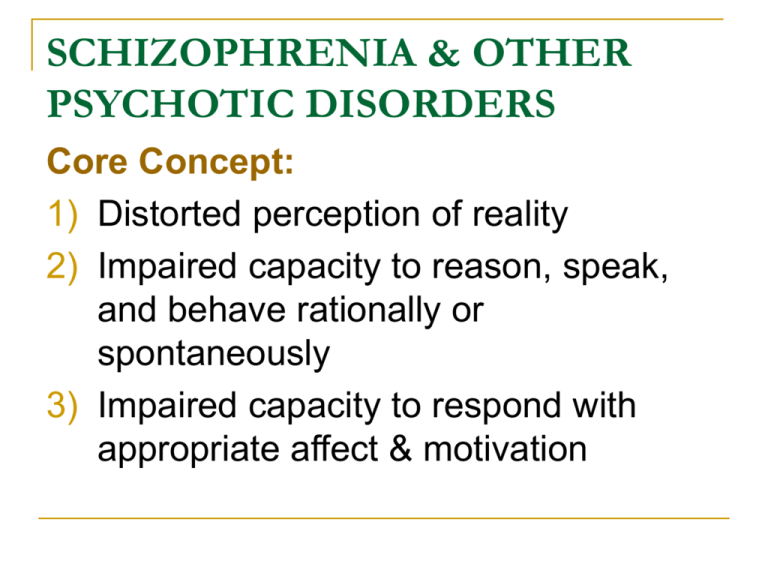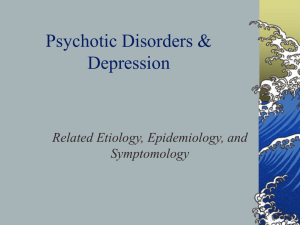SCHIZOPHRENIA & OTHER PSYCHOTIC DISORDERS
advertisement

SCHIZOPHRENIA & OTHER PSYCHOTIC DISORDERS Core Concept: 1) Distorted perception of reality 2) Impaired capacity to reason, speak, and behave rationally or spontaneously 3) Impaired capacity to respond with appropriate affect & motivation SCHIZOPHRENIFORM DISORDER A. 2 or more of the following sx are present for at least a month: delusions, hallucinations, disorganized speech, disorganized or catatonic behavior, negative sx B. R/O schizoaffective disorder, mood disorders, and the effects of a substance or general medical condition C. An episode of the disorder (including prodromal, active, & residual phases) lasts at least a month but less than 6 months Provisional diagnosis prior to 6 months. Shizophreniform Disorder: Specifiers Without Good Prognostic Features With Good Prognostic Features – as evidenced by 2 or more of the following: 1. acute onset of Sx 2. confusion or perplexity at height of psychotic episode 3. good premorbid social and occupational functioning 4. absence of blunted or flat affect Treatment Planning for Schizophreniform Disorder Psychoeducation Supportive therapy Maintenance antipsychotic medication Better prognosis Diagnostic Criteria for Schizoaffective Disorder A. Overlap of mood sx & psychotic sx B. 2 week period of psychotic sx without mood sx C. Mood sx are prominent & enduring part of clinical picture Specifiers: Bipolar Type – disturbance includes manic or mixed episode Depressive Type – disturbance includes major depressive episode Diagnostic Concerns for Schizoaffective Disorder Difficult to determine whether mood sx are of sufficient severity and duration to warrant dx of Schizoaffective (vs. schizophrenia) Difficult to determine whether psychotic sx occur only in the context of mood disorder (Mood Disorder with Psychotic Features) Dx applies only to a given episode of the disorder, not to lifetime course Treatment Planning for Schizoaffective Disorder No clear treatment guidelines Acute management: antipsychotic medication for psychotic sx; mood stabilizer for manic or mixed sx; antidepressant for depressive sx Maintenance treatment: medication management and compliance, psychoeducation, stress reduction DELUSIONAL DISORDER Diagnostic Criteria: Presence of 1 or more nonbizarre delusions (involve plausible situations, e.g. being followed, poisoned, infected, loved at a distance, betrayed by a lover, or having a disease) of at least 1 month’s duration. Aside from impact of delusion(s), functioning is not markedly impaired and behavior is not obviously odd or bizarre. Criteria A for Schizophrenia has never been met. Subtypes for Delusional Disorder Based on prominent delusional theme: Erotomanic: belief that another person, usually of higher status, is in love with you Grandiose: belief that you have inflated worth, power, knowledge, identity, or a special relationship to a prominent person Jealous: belief that lover is unfaithful Persecutory: belief that you’re being treated malevolently, e.g. cheated, conspired against, poisoned, spied on Somatic: belief that you have a physical defect or general medical condition Mixed: >1 of above themes; no 1 theme predominates Unspecified: central theme doesn’t fit other types Diagnostic Concerns for Delusional Disorder: Could beliefs be based in reality? Delusional beliefs vs. strongly held beliefs Could beliefs reflect person’s cultural and religious background? Could beliefs be due to the effects of a substance or general medical condition? Treatment Planning for Delusional Disorder Use of medication: antipsychotics, antidepressants Psychotherapy: confronting the delusion, reality testing, gentle probing Brief Psychotic Disorder Diagnostic Criteria: Presence of 1 or more of the following: Delusions Hallucinations Disorganized speech Grossly disorganized or catatonic behavior Duration: at least a day, but less than a month Diagnosis is given after person has fully recovered in less than a month. Specifiers for Brief Psychotic Disorder: With Marked Stressors: brief reactive psychosis Without Marked Stressors With Postpartum Onset: within 4 weeks postpartum Treatment of Brief Psychotic Disorder: Medication: antipsychotic Psychotherapy: aimed at helping individual cope with or escape from the stressor (if one is present)





